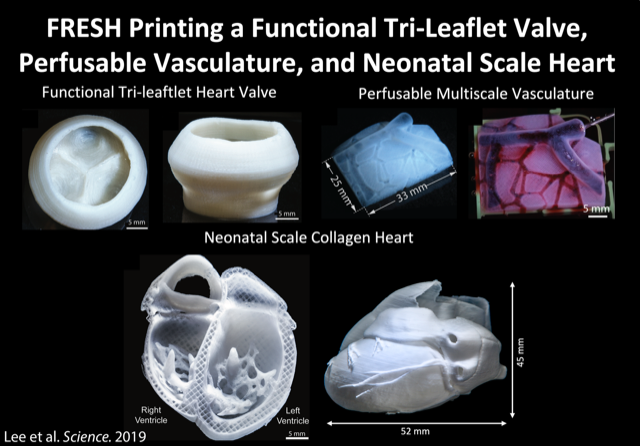A path for clinical translation of 3D-bioprinted human tissues
A perspectives piece authored by researchers in Carnegie Mellon University’s Regenerative Biomaterials and Therapeutics Group examines core challenges to overcome in the field of 3D bioprinting and essential milestones to translate to the clinic.
3D bioprinting is an emerging technology that has the potential to build human tissue, on demand, to treat a wide range of human diseases. However, bridging the gap from research at the benchtop to clinical translation requires a host of resources, time, and energy. A new Science Translational Medicine perspective authored by researchers in Carnegie Mellon University’s Regenerative Biomaterials and Therapeutics Group examines core challenges to overcome in the field of 3D bioprinting and essential milestones to translate to the clinic.
“This viewpoint takes into consideration technological advancements in the field to-date, as well as our opinion of the work that’s still needed in order to 3D bioprint patient-specific tissues for repair, regeneration, and replacement,” explained Jacqueline Bliley, a post-doctoral fellow and first author of the piece. “In the bioprinting space, our lab is best known for introducing FRESH technology, a technique that allows for the 3D printing of soft materials, including cells and extracellular matrix, into complex tissue architectures. This technology enables the fabrication of vascular scaffolds, heart valves, and even contractile heart muscle tissues.”

Source: Regenerative Biomaterials and Therapeutics Group
Summary of FRESH technology’s capabilities.
In terms of key challenges and requirements for translating 3D-bioprinted tissues and organs for human benefit, the group suggests that a series of advances are needed within the engineering, medical, and biological sciences. These include:
- Faster 3D bioprinters that create larger and more complex tissues
- Optimized bioinks and biomaterials
- The ability to expand large numbers of cells and differentiate them to target cell types
- Vascularization and perfusion of volumetric tissue
- Immune tolerance to ensure long-term viability in patients
- Nondestructive validation of tissue structure
- Validation of the tissue and organ function that will be required for successful clinical translation.
“In 2022, the first 3D bioprinted human tissue was implanted in patients, a major milestone,” said Adam Feinberg, a professor of biomedical engineering and materials science and engineering and co-author. “So now it is no longer a question of if we can bioengineer new tissues and organs, but rather when we can translate that to the clinic and achieve FDA approval so everyone can benefit.”
It is no longer a question of if we can bioengineer new tissues and organs, but rather when we can translate that to the clinic and achieve FDA approval so everyone can benefit.
Adam Feinberg, Professor, Biomedical Engineering and Materials Science and Engineering
A forward-looking timeline projecting dates for major milestones in the clinical translation of 3D-bioprinted constructs is presented in the piece. At the current pace of research, and barring changes in the regulatory landscape and current state of 3D bioprinting, 2042 is estimated as the timeframe for 3D-bioprinted solid organs to be approved as a clinical alternative for transplant, which would address the massive shortage in donor organs we face today.
While the field of 3D bioprinting continues to rapidly evolve, considerable challenges remain. Carnegie Mellon University is committed to advancing the narrative by taking a leading role in advanced research initiatives, including the Bioengineered Organs Initiative, a multi-disciplinary effort to create a new generation of long-term replacement organs, and key partnerships, including a multi-year research agreement with Mayo Clinic focused on transforming transplants.
